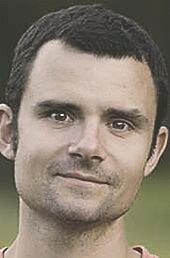Seventy-two hours before leaving my childhood home forever, I cross paths with my ninth-grade English teacher, whom I haven't seen in nearly two decades.
“Mrs. Hancock?” I ask.
It's 5:30 a.m., the day after Christmas. We are both out for our early-morning stroll.
She pauses at the sound of my voice – familiar yet forgotten.
“It's B.J.,” I say. “B.J. Hollars.”
“B.J.?” she says, releasing a slight chuckle. “How are you?”
“I think I owe you an apology,” I say. “Last night, while cleaning out my bedroom, I found some papers I wrote for you.”
She laughs.
“I mean, who quotes themselves in an epigraph?” I sigh miserably.
“What brings you here?” she asks.
My parents, who still live in Fort Wayne, though I left the city following my high school graduation in 2003. Ever since, my wife and I have faithfully returned to visit our families during holidays and summer vacation.
But now, I explain to Mrs. Hancock, we are leaving the city for good. My wife's parents have passed, and my own parents are selling their home to be closer to us in Wisconsin.
We are trying to stitch our worlds together, I explain.
Even if, I think, it feels like we're sewing one of our worlds shut.
For three mornings in late December, I continue my pre-dawn walks, which serve as my own personal Fort Wayne Farewell Tour. Stops include Lindley Elementary School, the Towpath Trail, and the fringes of Eagle Marsh Nature Preserve. Other highlights are a bit beyond walking distance: my last hike at Fox Island County Park and visiting my grandparents' graves at Lindenwood Cemetery.
But the place that holds the most meaning – and the most memories – is our family's Fort Wayne home: a 2,300 square-foot, mid-century ranch designed by my grandmother in 1955.
As childhood homes go, this place is special: complete with an Anne Frank-inspired spinning bookshelf (my grandparents were Jewish), two-sided cabinetry (they appreciated easy access to dinnerware, apparently), and a row of windows along the home's exterior which captured the morning light. Since its existence, no other family has ever lived within its walls.
Which is why it's so difficult to say goodbye.
All our family homes hold history, however momentous or mundane. In the fall of 1978, my parents were married in the backyard; a decade later, my grandfather and I tossed horseshoes in that very spot. I try to do the calculus but fail. How many birthday candles did we extinguish over the course of our collective 66 years there? How many hands of cards did we play? How many indulgent papers did I write?
On our last morning in the house, my wife and I buckle the kids into the van and wave goodbye to my parents. But before I put the van in reverse, sentimentality takes hold.
“I'm sorry,” I tell my wife, “I just need to make one last sweep of the house. You know, in case we forgot something.”
What I've forgotten, I realize upon reentering, is that the house is but one piece of what I'll miss. The deeper loss are the memories of generations of family members who once inhabited this sacred space.
And not just family members, but friends, too; not to mention others from our past who helped shape who we've become.
Bracing myself in the doorway of my childhood room, I at last put my family's dilemma into words that are precise and succinct: marks of good writing, as my ninth-grade English teacher once said.
We are choosing to leave a place we love in favor of the people we love.
It's as simple, and complicated, as that.
Past the bookshelf, and the cabinetry, and the windows, I make the walk back to the van.
I buckle, I breathe.
“Ready?” my wife asks.
“I think so,” I say.
We take Reckeweg to Illinois Road before hopping onto I-69.
For one lingering moment, I gaze into the rearview: securing the city – and its people – to memory.



